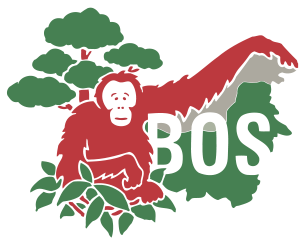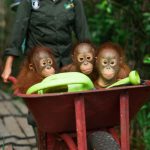Desi learns from the best
The BOS Foundation’s RHO Program team stationed at the Juq Kehje Swen Pre-Release Island in East Kalimantan conducts regular patrols to secure the island and collects observational data on orangutans. The individuals placed on the island have undergone the earlier stages of the lengthy rehabilitation process at the Samboja Lestari Orangutan Rehabilitation Centre.
Recently, the team set out to monitor Desi, an adult female orangutan whom we transferred to Juq Kehje Swen in June 2019. The purpose of monitoring Desi is to systematically observe her behaviours and determine whether she has developed sufficient survival skills to support her release into the wild.

Since her arrival on the island, the team had never seen Desi build her own nests; she had always chosen to use second-hand nests left by others. We know this because our team keeps a detailed log of the nests’ location and always found Desi in nests that they had already recorded.
Then, a few weeks ago, our team made a wonderful discovery. They spotted Desi emerging from a nest in an ebony tree, at the height of more than ten metres. The nest looked new, and the fact that it was not on our records indicated that Desi had built this nest herself. Moreover, the nest appeared untidy, as though an inexperienced orangutan had made it.
A week later, the team set out to locate Desi once again. This time, the team found a new, medium-sized nest in the top of a New Guinea walnut tree, between five and ten metres from the ground. It had a neat shape. We suspect this was also Desi’s work, as we had often spotted her in this area.

Well done, Desi!
Despite not seeing Desi build a nest with our own eyes, we believe she learned her new nest-building skills from wild orangutans. Desi must have watched them closely and started to mimic their actions. Mimicking is one of the best ways for orangutans to learn, as shown in the excellent progress that Desi has made over the 18 months she has lived on Juq Kehje Swen Island.
Keep on building, Desi!




